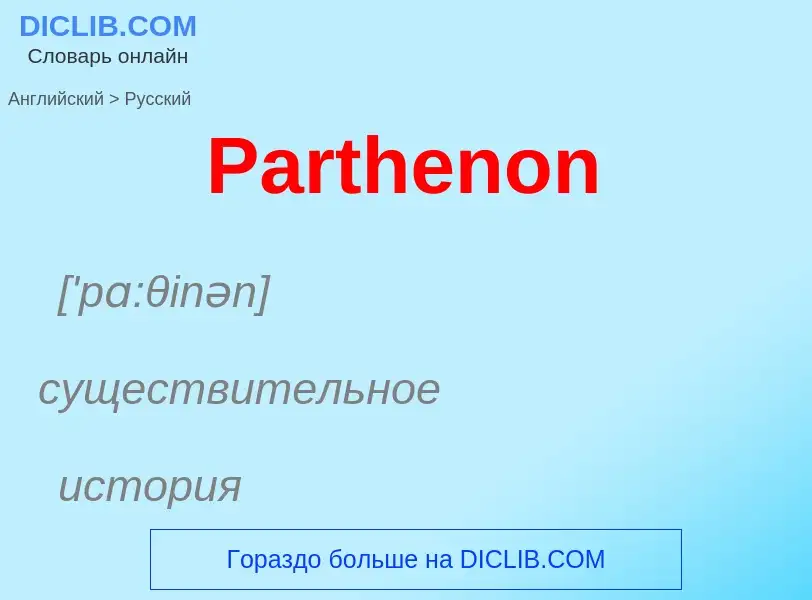Перевод и анализ слов искусственным интеллектом ChatGPT
На этой странице Вы можете получить подробный анализ слова или словосочетания, произведенный с помощью лучшей на сегодняшний день технологии искусственного интеллекта:
- как употребляется слово
- частота употребления
- используется оно чаще в устной или письменной речи
- варианты перевода слова
- примеры употребления (несколько фраз с переводом)
- этимология
Parthenon - перевод на русский
['pɑ:θinən]
существительное
история
Парфенон
['elgɪn,mɑ:blz]
общая лексика
элгиновские мраморы, мраморы Парфенона (коллекция античных скульптур в Британском музее [British Museum]; в неё входят части фриза Парфенона)
скульптуры были вывезены из Афин в 1803 графом Элгином [Earl of Elgin]
Определение
Википедия

The Parthenon (; Ancient Greek: Παρθενών, Parthenṓn, [par.tʰe.nɔ̌ːn]; Greek: Παρθενώνας, Parthenónas, [parθeˈnonas]) is a former temple on the Athenian Acropolis, Greece, that was dedicated to the goddess Athena during the fifth century BC. Its decorative sculptures are considered some of the high points of Greek art, an enduring symbol of Ancient Greece, democracy and Western civilization.
The Parthenon was built in thanksgiving for the Hellenic victory over Persian invaders during the Greco-Persian Wars. Like most Greek temples, the Parthenon also served as the city treasury.
Construction started in 447 BC when the Delian League was at the peak of its power. It was completed in 438; work on the decoration continued until 432. For a time, it served as the treasury of the Delian League, which later became the Athenian Empire. In the final decade of the 6th century AD, the Parthenon was converted into a Christian church dedicated to the Virgin Mary. After the Ottoman conquest in the mid-fifteenth century, it became a mosque. In the Morean War, a Venetian bomb landed on the Parthenon, which the Ottomans had used as a munitions dump, during the 1687 siege of the Acropolis. The resulting explosion severely damaged the Parthenon. From 1800 to 1803, the 7th Earl of Elgin took down some of the surviving sculptures, now known as the Elgin Marbles, in an act widely considered, both in its time and subsequently, to constitute vandalism and looting.
The Parthenon replaced an older temple of Athena, which historians call the Pre-Parthenon or Older Parthenon, that was demolished in the Persian invasion of 480 BC.
Since 1975, numerous large-scale restoration projects have been undertaken to preserve remaining artefacts and ensure its structural integrity.





![The [[Doric order]] of the Parthenon The [[Doric order]] of the Parthenon](https://commons.wikimedia.org/wiki/Special:FilePath/DoricParthenon.jpg?width=200)

.jpg?width=200)

.jpg?width=200)

![The [[Older Parthenon]] (in black) was destroyed by the Achaemenids during the [[Destruction of Athens]] in 480–479 BC, and then rebuilt by [[Pericles]] (in grey). The [[Older Parthenon]] (in black) was destroyed by the Achaemenids during the [[Destruction of Athens]] in 480–479 BC, and then rebuilt by [[Pericles]] (in grey).](https://commons.wikimedia.org/wiki/Special:FilePath/Parthenon ancient & Pericles, Maxime Collignon.jpg?width=200)


 - 2022-03-26 - 4.jpg?width=200)
![Part of the archaeological remains called ''[[Perserschutt]]'', or "Persian rubble": remnants of the destruction of Athens by the armies of [[Xerxes I]]. Photographed in 1866, just after excavation. Part of the archaeological remains called ''[[Perserschutt]]'', or "Persian rubble": remnants of the destruction of Athens by the armies of [[Xerxes I]]. Photographed in 1866, just after excavation.](https://commons.wikimedia.org/wiki/Special:FilePath/Perserschutt.gif?width=200)






![Statuary from the east [[pediment]] Statuary from the east [[pediment]]](https://commons.wikimedia.org/wiki/Special:FilePath/Parthenon pediment statues.jpg?width=200)
![A portrait depicting the Elgin Marbles in a temporary Elgin Room at the [[British Museum]] surrounded by museum staff, a trustee and visitors, 1819 A portrait depicting the Elgin Marbles in a temporary Elgin Room at the [[British Museum]] surrounded by museum staff, a trustee and visitors, 1819](https://commons.wikimedia.org/wiki/Special:FilePath/Temporary Elgin Room at the Museum in 1819.jpg?width=200)
![Metope from the Elgin Marbles depicting a [[Centaur]] and a [[Lapith]] fighting Metope from the Elgin Marbles depicting a [[Centaur]] and a [[Lapith]] fighting](https://commons.wikimedia.org/wiki/Special:FilePath/The Parthenon sculptures, British Museum (14063376069) (2) (cropped).jpg?width=200)
